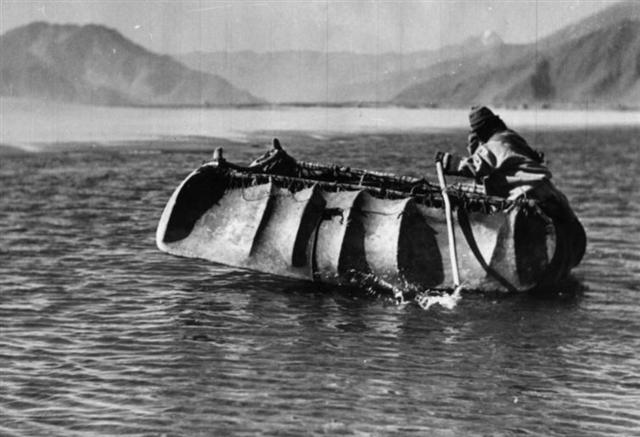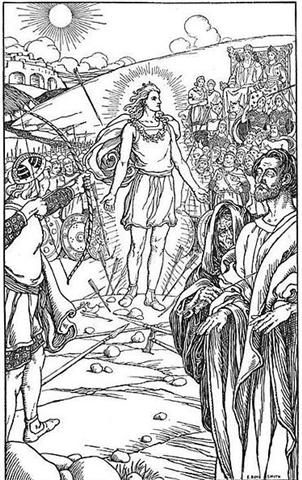Bb9.7
In the Babylonian zodiac, as we can see below, the Milky Way began to
rise up towards the north at Sagittarius as if to distance itself
from that part of the ecliptic which was ruled by the fishes:

... needfire ceremonies usually take place
near the summer solstice (the Feast of St. John) ... but they
occur in several other seasons as well. The summer date of the
rite and its accompanying festival have to do, among other
things, with fertility, as can can clearly be seen in a variant
from the valley of the Moselle preserved for us by Jakob Grimm.
Each household in the village was constrained to contribute a
shock of straw to the nearby high place, Stromberg, where the
males went at evening while the females went to a spring lower
down on the slope. A huge wheel was wrapped with this straw. An
axle run through the wheel served as the handles for those who
were to guide it on its downward plunge. The mayor of a nearby
town kindled the straw, for which office he was rewarded with a
basketful of cherries. All the men kindled torches and some
followed the burning orb as it was released downhill to shouts
of joy. The women at the spring echoed these shouts as the wheel
rushed by them. Often the fire went out of its own accord before
it reached the river, but should the waters of the river
extinguish it, an abundant vintage was forecast for that year
...
.jpg)
At
Φ Gemini, 5 days after Castor,
the season of the Fish was going away (reva). We can
count 54 days from Zaurak to the
night when Antares culminated (at 21h). Day 54 was February 23
(Terminalia). 365 + 54 = 7 * 60 - 1.
|
 |
 |
*53 |
 |
 |
|
ZAURAK |
VRISCHIKA |
ANTARES |
CASTOR |

North of the equator the day after
Terminalia (February 23) was doubled (Bissextum), and
south of the equator - where the seasons were upside down - a
kind of logic could therefore state that before
Terminalia a pair of nights were doubled.
 |
 |
 |
 |
*52 |
 |
 |
VINDEMIATRIX |
HYADUM I |
YED POSTERIOR |
AIN (*65) |
ALTAIR |
Φ Gemini |
 |
 |
 |
 |
 |
 |
 |
|
Bb9-21 |
Bb9-22 (348) |
Bb9-23 |
Bb9-24 |
Bb9-25 |
Bb9-26 (352) |
Bb9-27 |
|
RIGHT
ASCENSION DAYS AT THE FULL MOON: |
|
ρ Gemini (112.1),
Eskimo Nebula = NGC2392 Gemini
(112.2)
ANTARES (α Scorpii) |
Al Dhirā'-5 (Forearm)
/
Punarvasu-7 (The Two
Restorers of Goods) /
Mash-mashu-Mahrū-10
(Western One of the Twins)
CASTOR (Beaver) = α Gemini (113.4)
*113.4 = *41.4 + *72.0 |
ANA-TAHUA-VAHINE-O-TOA-TE-MANAVA-7 (Pillar for
Elocution)
υ Gemini (114.0),
MARKAB PUPPIS = κ Puppis
(114.7), ο Gemini (114.8),
PROCYON = α Canis Minoris
(114.9) |
α
Monocerotis (115.4), σ Gemini (115.7)
*74.0 = *115.4 - *41.4 |
Mash-mashu-arkū-11
(Eastern One of the Twins)
κ Gemini (116.1),
POLLUX = β Gemini
(116.2), π Gemini (116.9) |
AZMIDISKE (Little Shield) =
ξ
Puppis (117.4)
*76.0 = *117.4 - *41.4 |
φ
Gemini (118.4)
*77.0 = *118.4 - *41.4 |
|
HELIACAL STARS: |
|
ν
Aquilae (Ant.) (295.0),
ALBIREO - Hen's Beak =
β
Cygni
(295.5) |
ALSAFI (Fire Tripod) =
σ
Draconis
(296.0),
μ
Aquilae (296.3),
ι
Aquilae (Ant.)
(296.8), κ Aquilae (Ant.) (296.9) |
ε Sagittae (297.1),
σ
Aquilae (Ant.) (297.4),
SHAM (Arrow) = α Sagittae
(297.8)
*256.0
= *297.4 - *41.4 |
β Sagittae (298.0), χ Aquilae (298.3), ψ Aquilae
(298.8) |
υ Aquilae (299.1),
TARAZED (Star-striking Falcon) = γ Aquilae
(299.3), δ Sagittae (299.6), π Aquilae (299.9) |
Sravana-23 (Ear or Three
Footprints)
TYL =
ε
Draconis
(300.0),
ζ
Sagittae (300.1),
ALTAIR (Flying Eagle) =
α
Aquilae
(300.3),
ο
Aquilae (300.5),
BEZEK =
η
Aquilae (Ant.)
(300.8) |
ι Sagittarii (301.2),
TEREBELLUM = ω Sagittarii,
ξ Aquilae (301.3),
ALSHAIN (Falcon) = β Aquilae
(301.6), φ Aquilae (301.8) |

... so completely is
Aagjuuk identified with mid-December and
the winter solstice that one Igloolik
elder, invited to point to the constellation
in early November, firmly replied that we
would not see it until around Christmas, and
this in spite of the fact that Altair was at
the time in full view to the southwest ... |
|
Jan 10 (375) |
11 |
12 |
13 |
14 |
15 (380) |
16 |
|
NOV 10 (311) |
11 |
12 |
13 |
14 |
15 (316) |
16 |
|
ko te metimeti - ma to ragi - kua hua ia i raro |
ma te hokohuki - ki te henua |
kua haati ia e kava |
kava o te ariki |
e huarae - ma to
rima - ki te ragi |
e rere ia mai - ki to huki |
ko to huki ka to ihe
- kua reva te ika |
|
Reva
To hang down; flag, banner.
Revareva, 1. To be hanging vertically; to
detach oneself from the background of the
landscape, such a person standing on top of a
hill: ku-revareva-á te tagata i ruga i te
maúga. 2. To cast itself, to project itself
(of shadows); revareva-á te kohu o te miro i
te maeha o te mahina, the shadow of the tree
casts itself in the light of the moon. 3. Uvula.
Vanaga. To hang, to suspend, flag, banner;
hakareva, to hang up; hakarereva, to
hang up, to balance; hakarevareva, to
wave. T Pau.: reva, a flag;
fakarevareva, to hang up, to suspend. Mgv.:
reva, a flag, a signal. Mq.: éva,
to hang up, to be suspended, to wave a signal.
Ta.: reva, a flag, banner; revareva,
to wave. The germ sense is that of being
suspended ... any light object hung up in the
island air under the steady tradewind will
flutter; therefore the specification involved in
the wave sense is no more than normal
observation. Churchill. Mgv.: 1. A plant. Ta.:
reva, id. Mq.: eva, id. Sa.:
leva, id. Ma.: rewa-rewa, id. 2. To
cross, to pass across quickly; revaga,
departure. Ta.: reva, to go away, to
depart. Ma.: reva, to get under way.
Churchill. Ta.: The firmanent, atmosphere. Ha.:
lewa, the upper regions of the air,
atmosphere, the visible heavens. Churchill.
Ika
1. Fish. 2. In some cases, animal in general:
îka ariga koreh[v?]a, animal with the face
of a koreva fish (name given to horses
when they arrived on the island, because of the
resemblance of their heads with that of a
koreva). 3. Victim (wounded or killed),
enemy who must be killed, person cursed by a
timo and destined to die; îka reirei,
vanquished enemy, who is kicked (rei). 4.
Corpse of man fallen in war. Vanaga. 1. Fish,
animal; ika rere, flying fish; ivi ika,
fishbone; mata ika, pearl. P Pau., Mgv.,
Mq.: ika, fish. Ta.: ia, id. 2.
Prey, victim, sacrifice; ika ke avai mo,
abuse; hakarere ki te ika, to avenge. T
Mgv.: ikaiara, to quarrel; ikatamamea,
to be angry because another has handled one's
property. Mq.: ika, enemy, what causes
horror. Ma.: ika, the first person killed
in a fight. Mangaia: ika, a victim for
sacrifice. 3? matamata ika, snow.
Ikahi, to fish with a line, to angle. Mq.:
ikahi, id. Ikakato, to go fishing.
Ikakohau, to fish with a line, to angle.
Ikapotu, cape, end of a voyage,
destination; ikapotu hakarere, to abut,
to adjoin; topa te ikapotu, id.; tehe
oho te ikapotu, id.; mei nei tehe i oho
mai ai inei te ikapotu, as far as, to.
Ikapuhi, to fish with a torch. Mq.:
ikapuhi, id. Churchill. |
There was a flying Eagle who carried a Dead Man
in his claws, a pair of figures rising up together.


5 nights after the Full Moon had been at
Pollux the Full Moon would be at Naos,
and 5 days after the Sun had been at Tarazed (the Star-striking Falcon, γ Aquilae)
the Sun would be at 20h:
... After they had
departed from Pu Pakakina they
reached Vai Marama and met a man.
Ira asked, 'How many are you?'
He answered,
'There are two of us.' Ira continued
asking, 'Where is he (the other)?' To that
he answered, 'The one died.' Again Ira
asked, 'Who has died?' He replied, 'That was
Te Ohiro A Te Runu.' Ira asked
anew, 'And who are your?' He answered, 'Nga
Tavake A Te Rona.' [E:46]
→ Co-rona Borealis:
... In other words, the ancient Druidic religion
based on the oak-cult will be swept away by
Christianity and the door - the god Llyr - will
languish forgotten in the Castle of Arianrhod,
the Corona Borealis. This helps us to
understand the relationship at Rome of Janus and
the White Goddess Cardea who is ... the Goddess
of Hinges who came to Rome from Alba Longa. She
was the hinge on which the year swung - the
ancient Latin, not the Etruscan year - and her
importance as such is recorded in the Latin
adjective cardinalis - as we say in
English 'of cardinal importance - which was also
applied to the four main winds; for winds were
considered as under the sole direction of the
Great Goddess until Classical times ...

→ Va-runa:
... The Mahabharata
insists on six as the number of the
Pleiades as well as of the mothers of Skanda
and gives a very broad and wild description of
the birth and the installation of Kartikeya
'by the assembled gods ... as their
generalissimo', which is shattering, somehow,
driving home how little one understands as yet.
The least which can be said, assuredly: Mars was
'installed' during a more or less close
conjunction of all planets; in Mbh. 9.45 (p.
133) it is stressed that the powerful gods
assembled 'all poured water upon Skanda,
even as the gods had poured water on the head of
Varuna, the lord of waters, for investing
him with dominion'. And this 'investiture' took
place at the beginning of the Krita Yuga,
the Golden Age
...
 |
 |
 |
 |
 |
|
Bb9-28 (354) |
Bb9-29 |
Bb9-30 |
Bb9-31 |
Bb9-32 |
|
RIGHT
ASCENSION DAYS AT THE FULL MOON: |
|
DRUS (Hard) = χ
Carinae
(119.9) |
ω Cancri
(120.2) |
8h (121.7)
χ
Gemini (121.0),
NAOS (Ship) =
ζ
Puppis
(121.3) |
ρ
Puppis (122.0),
HEAP OF FUEL =
μ
Cancri
(122.1),
ζ
Monocerotis (122.3), ψ
Cancri (122.6),
REGOR (Roger backwards) =
γ
Velorum
(122.7) |
TEGMINE (The Cover) =
ζ
Cancri
(123.3) |
.jpg) |
|
HELIACAL STARS: |
|
ε Pavonis, θ Sagittarii (302.3), γ Sagittae
(302.5), μ Pavonis (302.7) |
τ Aquilae
(303.8) |
20h (304.4)
304.4 = 118.4 + 186.0
η Sagittae (304.2),
δ
Pavonis (304.4)
*263.0 = *77.0 + *186.0 |
SHANG WEI (Higher Guard) =
κ
Cephei
(305.2),
θ
Sagittae (305.4),
TSEEN FOO (Heavenly Raft) =
θ
Aquilae (Ant.)
(305.6), ξ Capricorni (305.8)
*264.0 = *305.4 - *41.4 |
TSO KE (Left Flag) =
ρ
Aquilae
(306.3) |
 |
|
Jan 17 |
18 |
19 (384) |
20 |
21 |
|
NOV 17 |
18 |
19 (320) |
20 |
21 |
|
kua hahaú
ia koia |
e rere koia |
ki ruga mai kia au |
kua rere mai ki te toga |
eaha te manu
rere toki -
ki te henua |
8h corresponded to right ascension day *121 (→
Beltaine) and 12h later was *304 (→ NOVEMBER 19)
at η Sagittae.

|

.jpg)
















.jpg)

